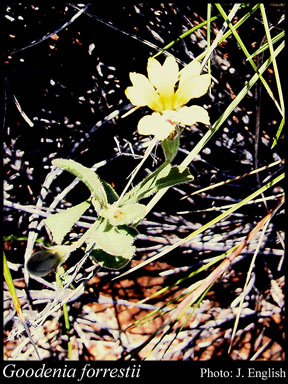- Reference
- Victorian Naturalist 9:58 (1892)
- Conservation Code
- Not threatened
- Naturalised Status
- Native to Western Australia
- Name Status
- Current
Ascending to decumbent herb, 0.1-0.3(-0.6) m high. Fl. yellow, May to Sep. Sandy soils, clay. Floodplains, rocky flats, roadsides.

Scientific Description
Stems unribbed. Leaves flat, 20-50 mm long, 6-25 mm wide, Indumentum present, with sparse, glandular hairs; margins entire or toothed. Bracteoles absent. Pedicel pedicellate, Pedicel length the pedicels 7-25 mm long, Indumentum present, Hair type with simple hairs. Calyx lobes present, Calyx length 4-6.5 mm long, hairy, with dense, glandular hairs. Corolla white or yellow, 15-19 mm long, auriculate, not spurred, hairy on the outside, with dense, glandular hairs, hairy on the inside; central lobes 3.8-5.5 mm long, with wings; outer lobes 9-11 mm long, wing present on both sides and clearly unequal, 1-2 mm wide on the narrower side, 1.5-2.2 mm wide on the broader side. Anthers free. Ovary inferior, not gibbose; style 7-9 mm long, hairy; indusium single, hairy; ovules more than two. Flowers in May, June, July, August and September. Occurs in the Pilbara (PIL), Carnarvon (CAR) and Gascoyne (GAS) IBRA Region(s), of the Eremaean (E) Botanical Province.
Distribution
- IBRA Regions
- Carnarvon, Gascoyne, Pilbara.
- IBRA Subregions
- Ashburton, Augustus, Cape Range, Chichester, Fortescue, Hamersley, Roebourne, Wooramel.
- Local Government Areas (LGAs)
- Ashburton, Carnarvon, East Pilbara, Exmouth, Karratha, Port Hedland, Upper Gascoyne.